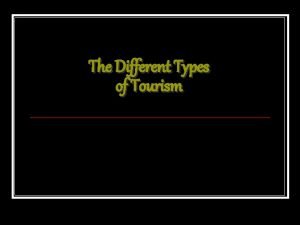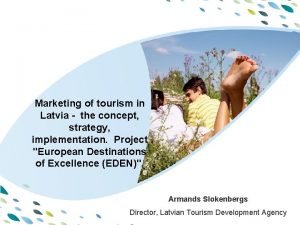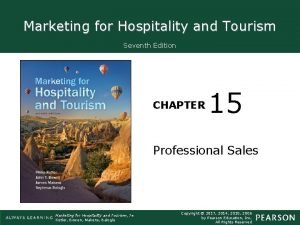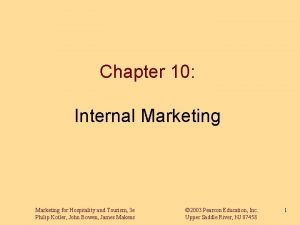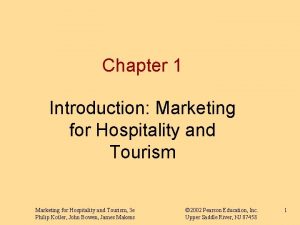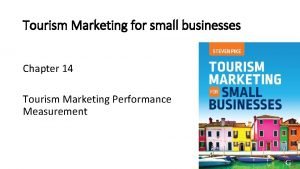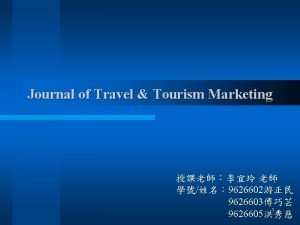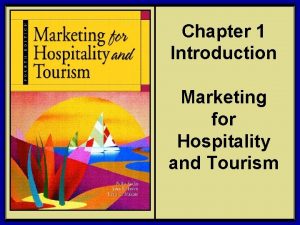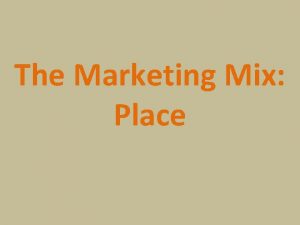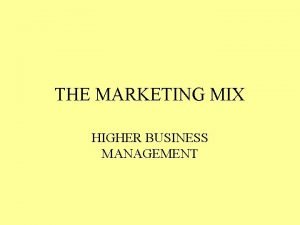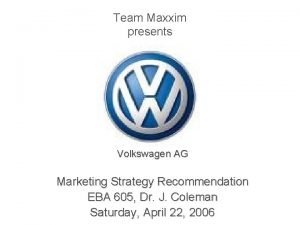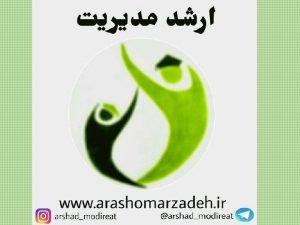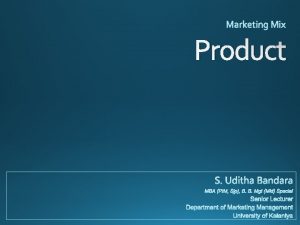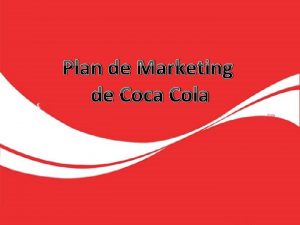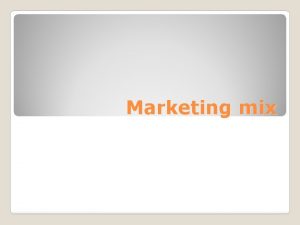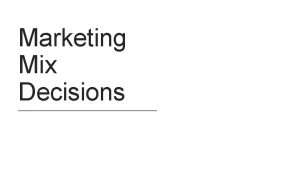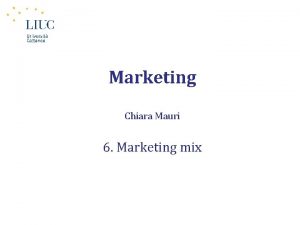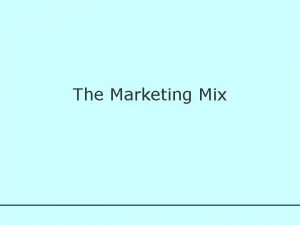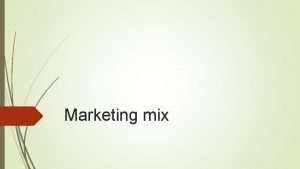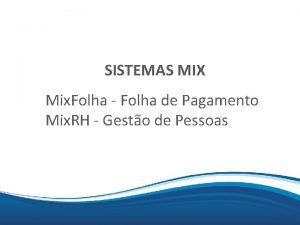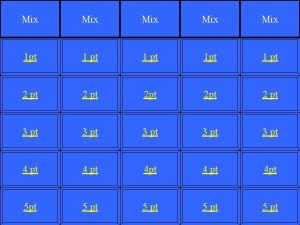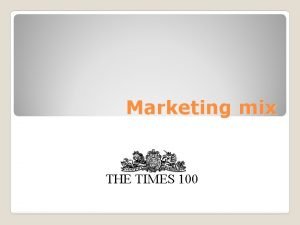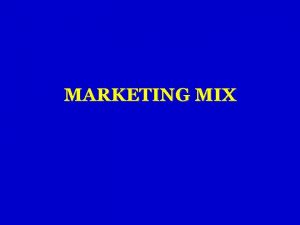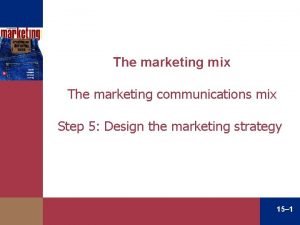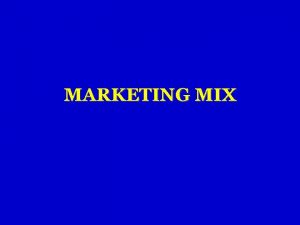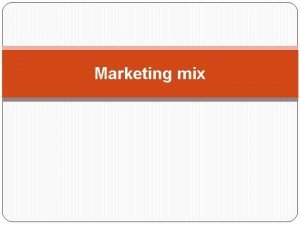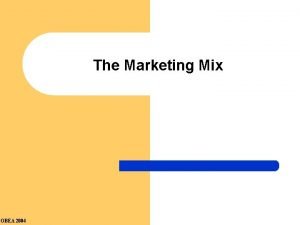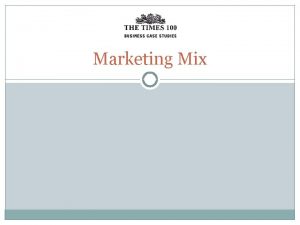Marketing mix of Marketing in Tourism Marketing mix
















- Slides: 16

Marketing mix of Marketing in Tourism

Marketing mix in Tourism • https: //www. youtube. com/watch? v=jmy. NNi. Ij. Z 1 o

• The marketing mix is set of tactical marketing tools – product, price, place, promotion – that the firm blends to produce the responsible it wants in the target market Philip Kotler

Marketing mix in Tourism Price People Promotio n Phys. Ev. Place Process Produc t Marketing mix in Tourism Programmin g

Product • Product is the combination of tangible and intangible elements. The tourism product, which is mainly the destination, can only be experienced. The views of the location travel to the destination, the accommodation and facility as well as the entertainment at the destination all form the tourism product. Thus it is a composite product combination of attraction, facilities and transportation. Each of these components has its own significance in the product mix and in the absence of even single components, the product mix is incomplete.

Price • Pricing of the tourist product is a complex matter because of its composite nature. Geographical location of the destination affects the pricing decision. At the same time, seasonality factor and varying demand cannot be overruled. The objective of pricing in any other firms is to fetch a target market share, to prevent competition, and to take care of the price elasticity of demand. • Pricing includes the prices of other services like Air travel, Bus, Railways, Hotels, etc. All are included in tourism package. Pricing also depends on the Geographic location of the destination. Pricing also depends on Seasonality.

Place • Different distribution strategies can be selected for Tourism marketing. Tourism as a product is distributed as a travel. Internet is also used widely. There is an also small agent spread all over the town who plays a role of place. Large travel companies like Thomas Cook, Cox & Kings, SOTC, etc they act as a wholesalers and these wholesalers also act as a retailer. • Different distribution strategies may be selected to reflect the company’s overall objectives. The middleman may be tour operators, who buy tourism products in bulk and make them available to travel agents who are retailers. The range of tourist products, which are bought by the tour operators are airline seats, hotel accommodation, bus for local sight seeing, etc. they may also sell directly to customers. The latest mode of reaching the tourist is through Internet. Ticket booking can also be done through the Internet and payment is made with credit card.

Promotion • Creation of awareness has a far-reaching impact. The tourist organizations bear the responsibility of informing, persuading and sensing the potential tourists in a right fashion. The marketers need to use the various components of promotion optimally so that they succeed in increasing the number of habitual users. Promotion helps in maximizing the duration of stay, frequency of visit by offering new tourist products in the same country to areas, which have remained untapped or partially tapped. The various dimensions of tourism promotion are as follows

People • It plays a most important part in tourism. • The personnel who attend to the needs of the tourists form an essential ingredient in tourism marketing. The sales personnel are responsible for dealing with the customer behind the counter. The airline and transportation crew interact with customers while traveling. The resort or hotel representatives enter to the needs of the tourist when they reach the destination.

Processing • The operation process of the tourism firm will depend on the size of the • • • tourism firm. The sequential steps involved in the delivery of the tourist products are: Provision of travel information Preparation of itinerates Liaison with providers of services Planning and costing tours Ticketing Provision of foreign currency and insurance

Programming • One way to add value to the standard product and to distinguish a particular offering from competitors is to offer exclusive programming, a practice known as service marketing. Customers will purchase a product that caters to their particular interests. Special programming can address such preferences and draw in additional customers.

Physical Evidence • The tourist attraction, which is an expensive for the customer must be tangibilised with the help of tangible items like, comfortable seats while traveling, layout, and design of the resort, natural service scope, etc. the sign posts that indicate directions, route maps, information regarding rules and regulations of the tourist spot and the sign regarding the public utilities like toilets, telephone booth also form a part of the physical evidence.

4 C´ • Whit market competition shifting from the product-oriented focus to a customer- oriented paradigm, some defects of the 4 P´s Framework emerge. • Under this condition, the 4 C´s marketing mix model is put forward by Robert Lauterborn, who suggest that the marketing strategies that involved 4 P are passé. • The C´s developed by R. Lauterborn are the customer decision points corresponding to the marketer tools. They are: • Customer solution • Cost to the user • Convenience • communication

4 C´ Product Costumer solution Customers look forward to solve their problems. Incidentally the solution is the product. In tourist the problem can be hot to best utilize the vacation, or how to have a break from the monotony in life Price Cost to the user May far exceed the price of the product. A tourists destination may focus on the economy of the expenses at the destination. Place (logistic) Convenience Even if there are multiple logistics options for tourists they will always weigh them as per their convenience. Convenience can again have multiple dimension. It can be convenience in terms of logistics, language, culture and travel Promotion Communicatio n Each destination undertakes an effort to promote itself in the most impressive manner. However, how it gets communicated is most important. A great web site, along with lovely advertisements can all go waste with the media report of harassment or exploitation of tourist or even the spread of some health threats some hundreds of miles

Case study 1 st part: • Read the text about 4 C´ in India 1. Make a tourist product (work in pairs/teams and create your own tourist product e. g. the trip on sport event to Pilsner)

Home Work • https: //www. youtube. com/watch? v=Ip. Vh 6 xttc. QM
 Product line and product mix examples
Product line and product mix examples Mass tourism vs alternative tourism
Mass tourism vs alternative tourism Tourism marketing strategy ppt
Tourism marketing strategy ppt Marketing for hospitality and tourism 7th edition
Marketing for hospitality and tourism 7th edition Internal marketing in hotel industry
Internal marketing in hotel industry Marketing for hospitality & tourism
Marketing for hospitality & tourism Tourism marketing objectives
Tourism marketing objectives Journal of travel & tourism marketing
Journal of travel & tourism marketing Ontario tourism marketing partnership
Ontario tourism marketing partnership Introduction to hospitality marketing
Introduction to hospitality marketing Place channel
Place channel Higher business extended marketing mix
Higher business extended marketing mix Volkswagen marketing mix
Volkswagen marketing mix Starbucks promotional mix
Starbucks promotional mix What is direct marketing in promotion mix
What is direct marketing in promotion mix Quality and design
Quality and design Foda coca cola
Foda coca cola

